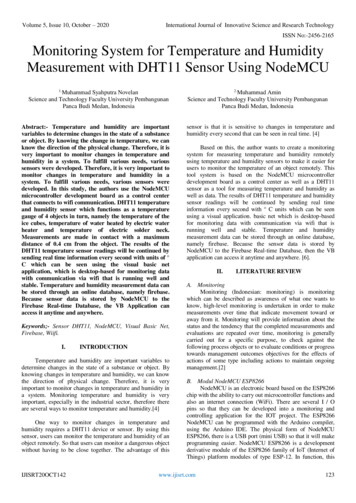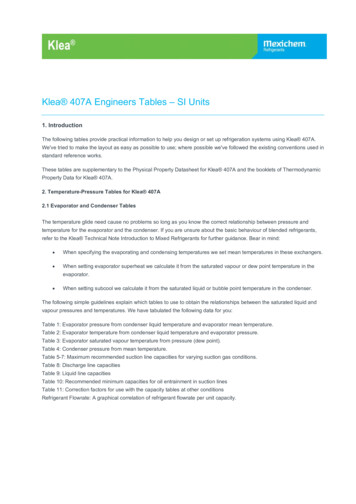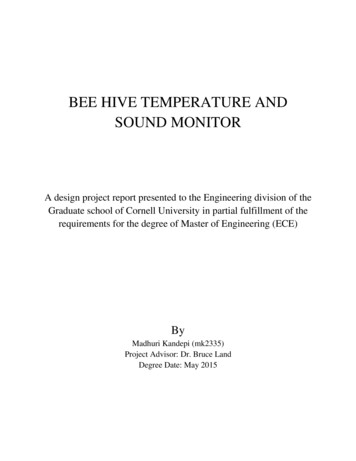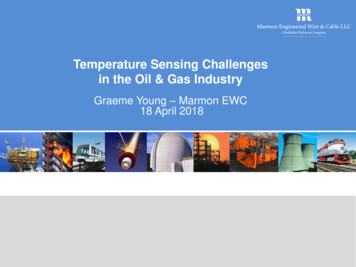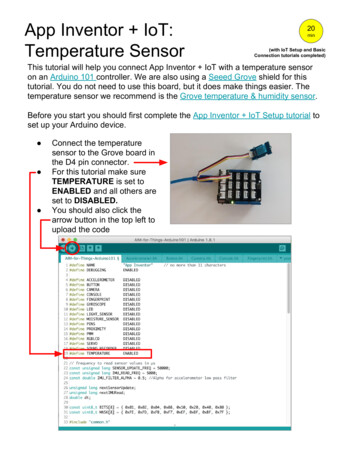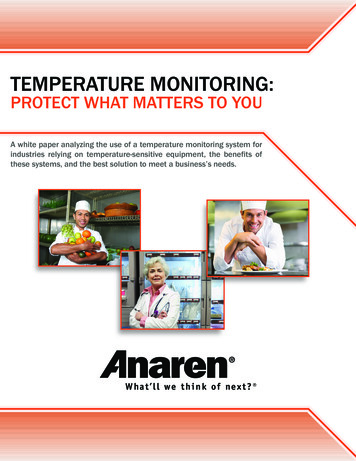
Transcription
TEMPERATURE MONITORING:PROTECT WHAT MATTERS TO YOUA white paper analyzing the use of a temperature monitoring system forindustries relying on temperature-sensitive equipment, the benefits ofthese systems, and the best solution to meet a business’s needs.
EXECUTIVESUMMARYValuable inventory. Costly infrastructure. Critical operations and equipment. Do you know if yours are safe?Every year, billions of dollars in business investments are lost when equipment doesn’t operate as planned.Refrigerators fail to refrigerate. Freezers don’t maintain low temperatures. Critical systems overheat or losepower. Quite simply, any time climate-sensitive conditions fall out of acceptable temperature ranges, the resultcan be unanticipated costs, possible litigation, compliance failures, and ruined inventory. Spoiled pharmaceuticals,foodborne illness, and unrecoverable data are just a few of the consequences that can result from this. Whetherthe context is a pharmacy, hospital, distribution facility, restaurant, data center, greenhouse or other location, suchhazards can be expensive and detrimental, and can increase the risk of liability and regulatory violations.Make temperature monitoring part of your business’s risk management strategy.Knowing when temperature-sensitive equipment failures occur can protect you from such devastating losses.Better yet, establishing the proper measures may often prevent these problems from happening in the first place.The solution, then, is through preventative monitoring of the things that matter to you. Constant monitoring ofyour valuable inventory, equipment, and assets provides a sense of security, with the assurance of knowing yourinvestments are safe and that you aren’t at risk for losses or damage. Additionally, constant monitoring producesvaluable data and reporting to ensure your facility always meets compliance and regulatory standards. However, youand your staff can’t be everywhere at once, at all times, to keep an eye on things and confirm they are protected.Even if they were, that would be inefficient, time-consuming, and prone to human error. So how do you know whensomething is wrong? Or do you know after it is too late?The ideal solution will: Provide around-the-clock temperature monitoring of the investments important to you. Be easy to use and customizable to monitor conditions based on your needs. Send immediate notifications and alerts to inform you the moment an issue occurs. Have a backup battery that properly and reliably operates despite power failures. Record accurate temperature data and status information at regular intervals, and generate reports used foranalysis and compliance needs. Be proven in the field to be effective and efficient.1
CAN YOU AFFORD TOLOSE YOUR INVENTORY?No matter the industry, businesses that rely on temperature-sensitive equipment all share an alarming problem: thethreat of that equipment failing. Broken parts, system malfunctions, temperature spikes, and power outages arejust a few of the common issues that can occur. If that happens, the inventory contained within the equipment is atrisk of being ruined and lost.Furthermore, these problems often develop with no warning or prior knowledge. Without a reliable means tomonitor inventory, you can be left with little time to react to such situations. Whether it is a refrigerator with criticalvaccinations, or a walk-in freezer stocked with hundreds of pounds of costly food, such equipment failures damageyour business and incur costs in more ways than just the initial loss of investments.There are four prevalent consequences of temperature-sensitive equipment failures:1 The loss of inventory and its associated trickle-down costs.Products stored within temperature-sensitive equipment have to be kept within specific temperature ranges andenvironments to maintain their freshness, efficacy, usefulness, and value. If conditions fall outside the neededranges, these products can only be sustained for a short period of time, if any, before they are ruined. Once theinventory is lost, their costs pile up and include:The cost of the inventory that was lost. Inventoryis valuable, and this cost alone can be staggering.According to a 2006 study done by the GeorgiaInstitute of Technology, perishable goods accountedfor 200 billion in profits annually for the supermarket(reach-in refrigeration) industry. However, 15 percentof the industry’s total losses were attributed to foodspoilage1.The cost of equipment downtime and its effect onother systems and processes. If the business isreliant on the failed equipment, it may see rippleeffects elsewhere.The cost to re-purchase the inventory, whicheffectively doubles the cost of the initial investment.The cost to quickly ship new inventory to the facility.The cost of efforts needed to correct the problem(disposal, cleaning, stocking, coordination, etc.). Thistakes time and efforts away from resources focusingon other areas of the business.The cost (in customer dissatisfaction) of delayedshipments, service, or deliveries to customers.The above only outlines the cost associated with the lost inventory itself, and doesn’t begin to factor the other threeconsequences. Can you calculate the potential costs of such losses for your business? Conversely, if your equipmentwere automatically monitored and a problem resolved, what would be the potential savings?2 The effects of potentially damaged products on the consumer.Many temperature-sensitive equipment failures are easy to spot; they fail, you notice the failure, repair the problem,then return to operation. But what if the power goes out overnight and subsequently returns several hours later,all without your knowledge? What if the equipment is continuously running at a temperature higher or lower thanexpected? The products within that equipment could be spoiled or damaged, yet they may still be delivered toconsumers. If consumers are provided with tainted products, there are numerous concerns and risks with their use.For example, if a vaccine is stored in a temperature outside its required range, whether it is too hot or too cold, itwill degrade and can lose its medicinal effectiveness, may not provide its intended therapeutic benefits, and mayeven have adverse effects on the human body. This can result in consumers receiving vaccinations that do notwork properly or at all, while unknowingly living without any protection.2
More specifically, in 2006 the Elsevier.com journal Vaccine publisheda meta-analysis that estimated 14 percent to 35 percent of all vaccinesare subjected to accidental freezing2. If a temperature excursion occurswithout being known or documented, potentially ineffective vaccines maybe unknowingly provided to patients. And in December, 2014, a swine fluvaccine was discovered to be ineffective as a result of being spoiled by heat,with only 20 percent of the batch maintaining its potency3. Once informed,consumers who were given this vaccine were then either inconvenientlyre-vaccinated or endured without it.35%UPTOOF VACCINES ARE SUBJECTED TOACCIDENTAL FREEZINGThis instance of a degraded swine flu vaccination was correctable because the vaccine issued was a preventativemeasure. However, this problem could have occurred in more urgent, life-saving healthcare products as well. If apatient is treated with a critical medication that suffers the same effects of spoilage, the consequences may be farmore severe and uncorrectable.The FDA estimates that every yearfoodborne illnesses cause:48 million people to become sickH128,000 people to be hospitalized3,000 people to be killedLikewise, the food industry has seen the effects of damagedand inedible products. According to the United States Foodand Drug Administration (FDA), roughly 48 million people(1 in 6 Americans) get sick, 128,000 are hospitalized, and3,000 die each year from foodborne illnesses4. This is atypical but largely preventable problem, as many of the mostcommonly-found bacterial pathogens creating foodborneillnesses are traced to improper storage and temperatureconditions of the contaminated products. Nearly 40 percentof foodborne illnesses and associated health risks are causedby temperature-related storage and holding of foods5.Beyond possible sickness resulting from poor temperature control, the environment food is stored in is critical tosustaining its quality. If food is kept above regulated temperatures, this not only increases the likelihood of foodborneillness and spoilage, but additional bacteria growth greatly affects its freshness and nutritional integrity as itsproteins and compounds deteriorate more rapidly, impacting the nutrients within the food and its flavor. Conversely,food exposed to unnaturally cold temperatures will also suffer physical spoilage. Food that accidentally freezes andthen thaws can suffer negative effects in terms of texture and appearance; skins and surfaces of products can crackand components can break down or separate, leaving them more susceptible to microbial contamination6.Indirectly, consumers who use damaged or ruined products are impacted in a number of other ways, includingincreased medical bills, loss of income, out-of-pocket expenses, physical pain, and emotional distress.3 Compliance/regulatory infractions and possible litigation.For businesses that maintain temperature-sensitive inventory, it is criticalthat the equipment’s performance is always compliant with various local,state, and federal standards and regulations. The FDA — through the FoodSafety Modernization Act (FSMA), United States Department of Agriculture(USDA), and Centers for Disease Control and Prevention (CDC) have allestablished highly specific mandates for properly storing and monitoringthese types of products to ensure they meet health and safety criteria.The CDC, for instance, requires all refrigeration and freezing equipmentcontaining vaccinations to maintain a temperature between 35 F to 46 Fand -58 F to 5 F respectively. Similarly, refrigerated and frozen foodproducts must be maintained at temperatures of 33 F to 40 F and below0 F respectively7. These temperatures are vital to preventing the spoilageof products and slowing the growth of pathogenic bacteria and remainingwithin health standards.3Over46 F46 F33 FTemperatures too high forstoring refrigerated products.Proper temperature range forstoring refrigerated products.5 F-58 FProper temperature rangefor storing frozen products.
If these regulations are violated, the business may suffer costly repercussions (e.g. fines, penalties, public notices,shut downs, etc.) from the governing agencies. This can lead to further disciplinary actions, and may also result inthe inventory being deemed as unsafe and needing replacement, thus the business also incurs the costs outlinedin section 1. Moreover, lack of compliance can result in costly lawsuits, settlements, and other legal action due tonegligence, misuse, breach of warranty (implied or written), or product failure.4 Damage to the business’s reputation, customer satisfaction, and loss of business.Many of the aforementioned consequences of temperature-sensitive equipment failures involve damages that aremeasurable. But what about effects that are unseen or difficult to quantify? Measurable or not, they can be just asdevastating, if not more so.A business’s good reputation can also be jeopardized as a result of poor temperaturecontrol, resulting in concerns about reliability, integrity, and trustworthiness.Consumers who have been negatively affected by poorly-maintained products haveendured a poor customer experience, and customer satisfaction will significantlydecrease if the problem is not resolved. This damage can be exacerbated throughthe use of social media. For example, consumers who have been made ill by aspoiled or ruined product will tell others about their bad experience. The formidableword of mouth made possible through social media or online reviews can have adetrimental impact on a business.Additionally, consumers and industry partners may be wary if these types of problems arise. Likewise, this canhave an internal impact on the existing workforce’s morale and hiring prospective employees. This affects thebusiness’s profits from multiple angles, from loss of consumer business and partnerships to a steady decline inworker performance, further affecting the business’s reputation and costs.Damage control, relief efforts, public relations, and even solid “crisis communication” programs can only do so muchto mend such relationships or blemishes to a company’s good name. However, if a reliable monitoring system is inplace, such disasters can be prevented from happening in the first place. Inventory, consumers, and relationshipsare all important to help a business succeed. No business wants to be at risk to lose these valuable investmentsand suffer expensive costs. This makes things clear: a system designed to protect those things should be used inconjunction with temperature-sensitive equipment.4
SOLVE THE PROBLEM:UTILIZE A TEMPERATURE MONITORING SYSTEMUsing a reliable temperature monitoring system to prevent problems that result from temperature-sensitiveequipment failures is just “good business.” The advantages of utilizing such a system extend to all facets of abusiness and greatly reduce the risk of incurring those unanticipated costs: Having an accurate measurement of the equipment’stemperatures provides a far better understandingof the inventory’s status. This will also providereassurance that the inventory’s quality is maintainedand can help prevent issues of unexpected spoilage orunknowingly shipping spoiled or damaged products. Continually monitoring temperatures assists in earlyfault detection and preventative maintenance of theequipment (e.g. noticing abnormal temperature cyclesmay indicate a faulty compressor, or consistently lowtemperatures may indicate the equipment needsservice). Accurate temperature readings can develop a strongerprediction of the shelf-life of inventory, and can helpin detecting earlier stages of product abnormalities ordegradation. Monitoring promotes compliance and eases reportingrelative to regulations by confirming the equipmentis up to code and meets specific health and safetystandards.These are just a few of the basic benefits of temperature monitoring. Granted, industries that rely on temperaturesensitive equipment generally have some semblance of monitoring in place; no business is intentionally neglectfulof their inventory. But the methodology for monitoring varies, and as such knowing all of the options available, alongwith their benefits and weaknesses, is essential for determining what best meets your needs. For the purpose of thisdiscussion, monitoring capabilities are broken into three options: manual logging, wired systems, and wireless (aka:Wi-Fi) systems.Regardless of the type of system being used, there are two key functions that a temperature monitoring systemshould perform: Logging: Regular recording of data for analysis and compliance purposes, and performed at a set interval (e.g.every hour, every day, etc.). This may help with knowing if equipment is functioning correctly or is in need ofmaintenance. Alarming: In addition to logging, the immediate notification of an issue with the monitored equipment (e.g.temperature out of required range, loss of power, etc.). This may proactively alert you of a problem or if inventoryis at risk, and whether appropriate measures have been taken to address inventory at risk.Temperature Monitoring SystemsManual LoggingWired SystemWi-Fi SystemTraditional means of monitoring using a thermometer in the equipment and manually recordingthe temperature on a log. This typically involves an employee visiting the equipment at certainintervals, checking its temperature, and then writing the temperatures on a log sheet.An automatic monitoring system installed with the use of wires (e.g. Ethernet, cable, etc.)connecting directly to the equipment to be monitored. Wired systems monitor temperaturesand transmit the data typically to an ERP system or to a third party resource such as a cablecompany or security service.This type of system monitors temperatures within designated equipment, conveying the datavia a local Wi-Fi connection to an online server or email address.There are several advantages and disadvantages for these monitoring systems, and examining them furthercan help you take the next step in deciding what is right for you.5
Manual LoggingAdvantagesDisadvantages Easy to implement. There is little capital equipment or process development cost needed.This is practical for businesses on a strict budget. Widely understood method that requires little training or organization to implement. No alarming capabilities. Without around-the-clock monitoring, there is no knowledge of anovernight issue until the following morning, or an issue that occurs during a holiday or otherday without work until a return to the facility. Manually checking temperatures only indicates the equipment’s status at that particulartime. Temperatures can fluctuate outside of needed ranges between those times, and thebusiness would not be aware of this. Can be costly by calculating the salary needed to have an employee routinely monitorequipment. Potentially time-consuming and inconvenient process; employees physically recordingtemperatures will take time away from their other tasks. Requires a dedicated monitoring schedule, which can be easily interrupted due to relianceon employee availability. Inconsistent manual monitoring and recording may not notice or recognize compliance orlegislative violations. Paperwork can be lost, incorrectly or inaccurately recorded, or falsified. This opens up thepossibility of liability issues, but can be avoided if manual recording is done using a digitaldevice. Manual logging is prone to human error, either indirectly or willfully.Wired Monitoring SystemAdvantagesDisadvantages6 Remote monitoring solution that automatically monitors temperature at all times withoutthe need to physically check equipment Provides built-in record keeping that tracks data and verifies inventory is safe and equipmentis compliant. Can provide an email or text message notification to the user in the event an issue is detected. Many wired monitoring systems are integrated into the equipment direct from themanufacturer, reducing the cost and time associated with adding monitoring functionalityand hardware. Potentially expensive or invasive installation process. Requires dedicated wiring andhardware to be installed, and is limited with respect to where it can be installed based onthe equipment it monitors. Systems built into equipment itself may limit configuration and installation options for theequipment. Installation also can be troublesome if numerous pieces of equipment need monitoring,extending the amount of wiring needed and increasing disruption. System is not designed to handle emergencies and is prone to power outages. Wired systemshave no means of offering protection or notifications if such an issue occurs. Monitoring charges through a third party service can be expensive.
Wi-Fi Monitoring SystemAdvantagesDisadvantages Remote monitoring solution that automatically monitors temperature at all times withoutthe need to physically check equipment or divert manual resources. Seamless installation that can be flexible based on the needs of the facility. Through thedeployment of wireless sensors and devices, installation may be quick and can be donewithout professional assistance. Provides built-in record keeping that tracks data and verifies inventory is safe and equipmentis compliant. Can provide an email or text message notification to the user in the event an issue is detected. Recorded data is available to be viewed through spreadsheets or online services. Wireless Wi-Fi systems may have backup battery power to temporarily protect themselvesagainst power outages, but the loss of power still causes the Internet service provider to losepower. Wi-Fi systems have no means of offering protection or sending notifications if suchan issue occurs. Wi-Fi systems will only work where there is Wi-Fi access. If an area that requires monitoringis not currently served by Wi-Fi, then the network would need to be extended into that area,incurring equipment and labor costs. Wi-Fi systems are prone to poor performance during Internet downtime or from poorconnections. Wireless Internet may also be subject to interference, which can temporarilydisable sensors or cause them to respond unpredictably. Can cause potentially slow Internet service at the facility if the system suffers from bandwidthissues as a whole.Each of these monitoring systems provides something that the others do not. However, none of them offer the levelof support and security that would be provided by an ideal solution, because they do not cover all of the requirementsoutlined (see page 1) to meet those needs. Power failures, for instance, are among the most common threatsto temperature-sensitive equipment, yet none of these systems are able to reliably operate during them. If thesesystems cannot provide the support needed during such a critical time, an alternative solution that does should beexplored.7
SEPARATING FROM THE PACK:CELLULAR MONITORINGFor those who want the convenience of an automatic monitoring system, but do not want to be left in the dark if thepower fails, there is a fourth type of monitoring system available: cellular.Compared to wired and Wi-Fi monitoring systems, a cellular-based monitoring solution operates in a similar fashion,offers the same level of support, and delivers the same functionalities: it provides a remote means of monitoringtemperature; it records data logs and produces reports; and it sends notifications to the user whenever an issue isdetected. Also like Wi-Fi systems, the cellular solution is wireless, providing installation flexibility and customization,and convenience through remote system management.Where the cellular solution differs from — and outperforms — other options is its use of the cellularsystem as the basis for communication. With communication managed via a cellular network, thecellular solution offers a distinct advantage over hard-wired electrical or Wi-Fi-based systems: itreliably operates in the wake of power outages. With the support of backup batteries, generators,and independent power grids, cellular-based monitoring systems retain power for long periods oftime despite the loss of city power. Data will still be transmitted, and more importantly, notificationswill still be forwarded even if power is lost. This means alerts are sent as soon as issues arise andregardless of the circumstances, and you can react swiftly to prevent harmful and costly problems.Additionally, cellular networks aren’t subject to common interference and disruptions that can plague a local Wi-Ficonnection. And today’s cellular systems offer nearly ubiquitous coverage, so temperature monitoring can occureven in remote areas.8
THE IDEAL SOLUTION:Shown: The Cellular Machines control station and three wireless pods.Between its ability to operate despite power failures and the cellular network’s consistent and far-reaching coverage,the cellular monitoring system provides the most reliable and sustainable service available. It is the only solutionthat addresses all of the criteria set out on page 1 of this white paper. Again, these are: Provide around-the-clock temperature monitoring of the investments important to you. Be easy to use and customizable to monitor conditions based on your needs. Send immediate notifications and alerts to inform you the moment an issue occurs. Have a backup battery that properly and reliably operates despite power failures. Record accurate temperature data and status information, and generate reports used for analysis and complianceneeds. Be proven in the field to be effective and efficient.Knowing the best available solution is the first step. The next is finding the best supplier of that technology. Again, anideal solution needs to meet the above requirements in order to offer the highest level of monitoring service.Anaren’s Cellular Machines Temperature Monitoring System is the solution that meets all of this criteria. Designedto remotely and efficiently provide monitoring solutions for a variety of needs, the Cellular Machines TemperatureMonitoring System can be seamlessly integrated into most temperature-controlled equipment scenarios, andinstalled in under 15 minutes.9
How does the Cellular Machines Temperature Monitoring System work?Anaren’s Cellular Machines Temperature Monitoring System continuously monitors temperatures for a variety ofsystems and equipment that must be maintained in controlled environments. This is accomplished by utilizing: A centralized control station to manage the system. The deployment of wireless pods and temperature sensors within equipment to monitor temperature readingsand detect variances. An outside cellular network to send notifications to up to five mobile phones and data to a cloud server to belogged for viewing and compliance reporting.Temperature limits are established for the monitored equipment, and the temperature sensors monitor theequipment to ensure its environment remains within that range. At regular intervals, the sensors wirelessly sendreadings to the control station, which concurrently logs the data to a cloud server. If a sensor detects a temperatureoutside of the set range, or any other issue such as a power failure, the control station will immediately send a textmessage alert to the connected mobile phone(s) to inform you of the problem.Here is an example (using our standard Cellular Machines Temperature Monitoring Kit) of how the TemperatureMonitoring System works after it is installed:The wireless pod(s) are attachedto their respective equipmentto be monitored. The pods’temperature sensors arestrategically placed inside ofthe equipment.The wireless pod(s) willcontinuously send temperaturedata via a wireless connection tothe control station. The controlstation then connects to thecellular network.Data alerts and notificationsare sent via the cellular networkto up to five designated mobilephones. This data is alsoregularly logged to a cloudserver for viewing, analysis, andreporting purposes.How the Cellular Machines Temperature Monitoring System meets the “ideal” requirements.Examining what the Cellular Machines Temperature Monitoring System offers can provide clarity on how it fulfills theideal system requirements and fits into your business’s risk management strategy. Around-the-clock temperature monitoring of the investments important to you.As soon as it is installed, the Cellular Machines Temperature Monitoring System begins to operate 24/7 withoutdisruption. It will provide data, status information, and alerts at all hours, allowing you to focus your attention andefforts elsewhere.10
Easy to use and customizable system that monitors conditions based on your needs.The Cellular Machines Temperature Monitoring System requires very little instruction and guidance to set up anduse. It can be installed out of the box in under 15 minutes, without the assistance of a professional or IT department:simply attach the control station to a surface and plug it in, attach the wireless pods to their monitored equipment,and place the temperature sensors inside the equipment to be monitored. That’s all: no wiring or hardware needed.Installation is also very flexible, as the wireless pods have connectivity ranges of several hundred feet to the controlstation. This opens up a variety of installation options, as the system can be operated despite all of its componentsbeing great distances from each other. Additionally, the system can be expanded to monitor up to 16 separate assets.Simple naming options of the system’s components also allow you to customize the system to your needs. Temperaturelimits, sensor names, temperature scale, alarm delay times, status updates, text message notifications, and reportinginformation are among the plethora of options that can be customized. Better yet, the ability to personalize thesystem can be done from the device itself or through the Cellular Machines online user dashboard, providing theflexibility of managing your system no matter where you are. Send immediate notifications and alerts to inform you the moment an issue occurs.Utilizing the reliable cellular network, the Cellular Machines Temperature Monitoring System’s control station willsend a text message alert to a mobile phone once an issue is detected. These alerts will include the alarm inquestion, as well as the current status of every temperature sensor connected to the system. Temperature issues,equipment conditions, system status, power outages, and low battery power are just a few of the many types ofissues that can be detected.General status updates can also be received on a daily basis to notify you of thecondition of all equipment being monitored. This is a convenient proactive measurethat allows you to have eyes on your investments, and know how things are goingeven when you are not at the facility.Additionally, the system is able to send text message alerts to up to five mobilephone numbers, providing information to everyone who needs to know criticalequipment information. Backup battery that properly and reliably operates despite power or equipment failures.As mentioned earlier, the use of a cellular network in favor of a hardwired electronic or wireless Internet connectionboasts several benefits. Cell towers and antennas are resilient and do not easily lose their functionality during poweroutages, thanks to the support of backup batteries and generators. Even with the loss of
A white paper analyzing the use of a temperature monitoring system for industries relying on temperature-sensitive equipment, the benefits of these systems, and the best solution to meet a business's needs. TEMPERATURE MONITORING: PROTECT WHAT MATTERS TO YOU. 1 Valuable inventory. Costly infrastructure.

